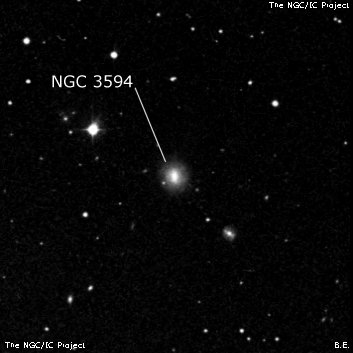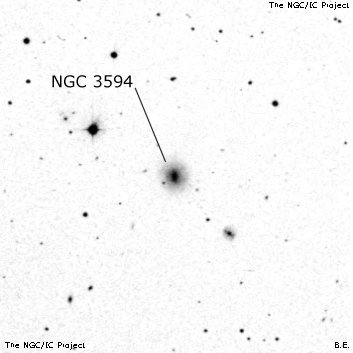NGC/IC Project Restoration Effort
(This is a very very beta version)
NGC3594


Basic Information
Location and Magnitude
Right Ascension: 11:16:13.9
Declination: +55:42:17
Constellation: UMA
Visual Magnitude: 13.7
Historic Information
Discoverer: Herschel W.
Year of discovery: 1789
Discovery aperture: 18.7
Observational
Summary description: vF, vS, stellar
Sub-type: SB0
Corwin's Notes
=====
NGC 3594. The NGC position falls between two galaxies that could be the
object WH saw. The "standard" identification is with UGC 6286, though
another possibility is CGCG 268-006, smaller but brighter than the UGC galaxy.
However, it is considerably further from WH's positions than the UGC galaxy.
Checking WH's sweeps (CH's fair copy in the Herschel Archives) gives another
two positions, one from CH's reduction, the second from an offset from "279
Ursae of Bode's Cat." which turns out to be HD 100615. Both of these
positions (given in the position table), are closer to UGC 6286 than is the
position reduced from WH's 3rd list in his Scientific Papers. This suggests
that the usual identification is correct.
However, I noticed that a few other galaxies that WH found on the same night
also had identification problems (specifically those flagged with Notes by
Dreyer in the 3rd list in the Scientific Papers). Curious about this, I
collected all of WH's observations from the night of 14 April 1789 that he
referred to 64 Ursae Majoris. I've listed them here with WH's positions
reduced from the offsets, given in the 3rd list, to the modern position of the
star (corrected for proper motion). The differences, in the sense "True minus
WH" follow, with a few notes appended. I've ordered them by declination; the
reason for that is obvious, and is discussed below.
NGC H RA (2000) Dec Delta Pos (T - WH) Notes
RA Sec Dec Min
3780 I 227 11 38 51 +56 19.0 +31 -2.8
3804 III 773 11 40 16 +56 14.0 +38 -1.9 = NGC 3794
3898 I 228 11 48 40 +56 05.8 +35 -0.7
3594 III 770 11 15 29 +55 45.3 +43 -3.0
3888 II 785 11 47 00 +55 59.8 +34 -1.8
3850 III 776 11 44 34 +55 53.9 +61 -0.7 WH notes "time inaccurate"
3990 II 791 11 57 08 +55 29.6 +28 -2.1
3998 I 229 11 57 29 +55 28.6 +27 -1.4
3913 II 786 11 50 25 +55 20.7 +14 +0.5
3972 II 789 11 55 22 +55 19.6 +23 -0.4 Obs includes N3977=N3980
3916 II 787 11 50 53 +55 08.7 - 2 -0.1
3921 II 788 11 50 48 +55 05.7 +19 -1.0
3737 III 772 11 35 21 +54 58.2 +15 +1.3
3733 III 771 11 34 47 +54 50.2 +15 +0.8
3738 II 783 11 35 41 +54 32.2 + 8 -0.7
3756 II 784 11 36 38 +54 19.1 +10 -1.4
3656 II 782 11 23 34 +53 49.8 + 5 +0.7
3631 I 226 11 21 11 +53 08.9 - 8 +1.3
3824 III 774 11 43 28 +52 43.9 -43 +2.9
3829 III 775 11 43 47 +52 40.9 -20 +1.8
Mean Delta +16.7 -0.44
Sigma n +- 5.1 +-0.34
Sigma 1 +-22.8 +-1.54
Note that the largest declination and RA offsets occur at the extreme northern
and southern limits of the sweep. While the mean RA difference is west by
16.7 seconds of time (or about 2.4 arcminutes at the mean declination), and
the mean Dec difference is 0.44 arcmin north, the trends in both RA and Dec
with declination are clear. I'm going to suggest that, as on the notorious
night of 2 April 1801 (see NGC 3752 for details), WH was not sweeping along
the meridian, but along a great circle turned at some small angle to the
meridian.
All this suggests that UGC 6286 is indeed WH's galaxy, and is the correct
identification for NGC 3594.
Steve's Notes
=====
NGC 3594
17.5" (3/12/88): faint, very small, round, bright core. A mag 11 star is 2.7' ENE.



